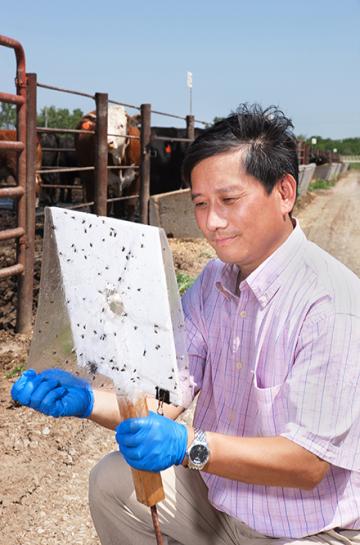Attracting Bloodsucking Flies to a Sticky End

ARS entomologist Jerry Zhu examines stable flies captured on a sticky trap baited with his newly designed attractant, or lure.
Bloodsucking insects are a serious problem in agriculture as they inflict painful bites that induce weight loss, decreased milk production, and other harmful stress responses in livestock animals. Stable flies are notoriously some of the costliest and damaging of the bunch, causing approximately $2 billion in damages annually.
According to ARS research entomologist Jerry Zhu, there are unfortunately few methods to control stable fly infestations, except for traditional insecticides.
To address the need for better ways to combat these bloodsucking critters, Zhu and his team at the Agroecosystem Management Research Unit in Lincoln, NE, developed several novel attractants capable of luring in flies. With industry partners, he and his team discovered that applying these attractants onto adhesive surfaces could bring double the fly-fighting power.
“Although the concept of sticky traps for pest control isn’t new (for example, fly paper), infusing them with specially tailored chemicals to attract bloodsucking bugs is a comparatively novel insect reduction technique,” explained Zhu. “The key to its efficacy is the use of semiochemicals, or ‘signal chemicals,’ which are any substances that an organism releases to affect the behaviors of others. This class of substances includes pheromones and the attractants that we have applied to our unique tape traps.”
In the natural world, stable flies are attracted to semiochemicals that can be found in crop residues, postharvest wastes, or cattle rumen and manure. The insects use these signal chemicals to navigate potential egg-laying sites or to identify potential hosts to feed from. With these newly developed sticky traps, however, the insects are aggressively lured by those powerful attractant semiochemicals onto sticky surfaces and can no longer feed on cattle. Furthermore, the captured stable flies cannot transmit any contagious diseases that they might be carrying, such as trypanosomiasis, besnoitiosis, and lumpy skin disease. Altogether, the insect tape traps are capable of reducing animal stress by approximately 80 percent.
“Using attractant adhesive tape traps is kind of like a two-for-one deal,” Zhu said. “The sticky traps not only directly decrease stable fly population where they’re applied but they also help farmers and scientists better monitor the environment around their animals. The sticky traps act as a physical record of insects that are in proximity to the cattle, allowing us to see whether a stable fly outbreak is brewing or if there are new insects entering their barns.”
There are other advantages to this novel attractant-imbued adhesive trap, such as its relative inexpensiveness and user-friendliness. Previous traps that used attractants involved using a variety of devices to trap and dispense attractant compounds, which were both too costly and too complicated to be practical for animal farmers. Zhu and his team ultimately hope that their new sticky trap will enable farmers and livestock owners to better protect their animals and prevent future outbreaks or infestations. – by Georgia Jiang, ARS Office of Communications.
You May Also Like

